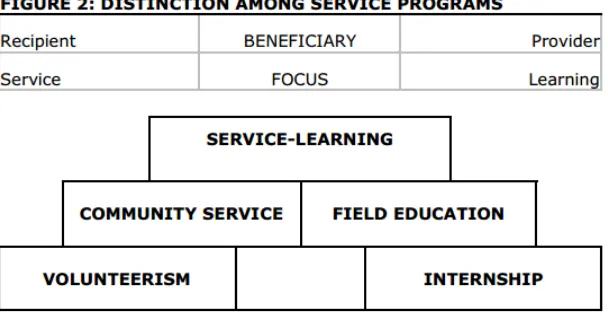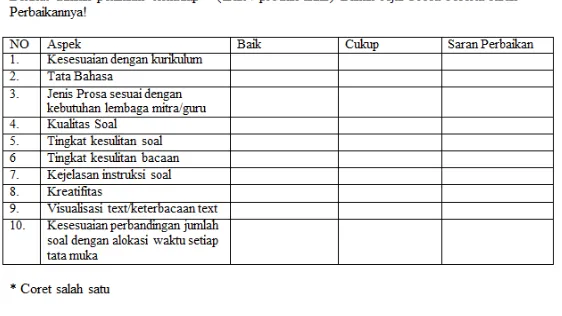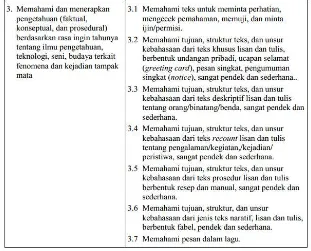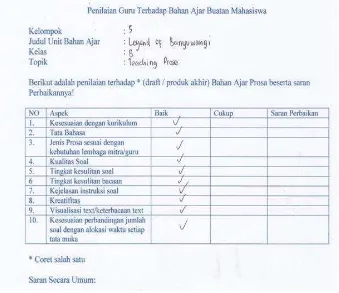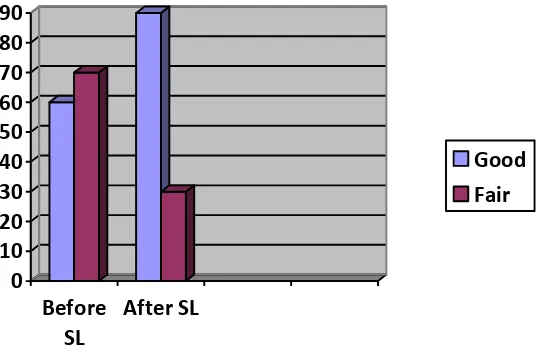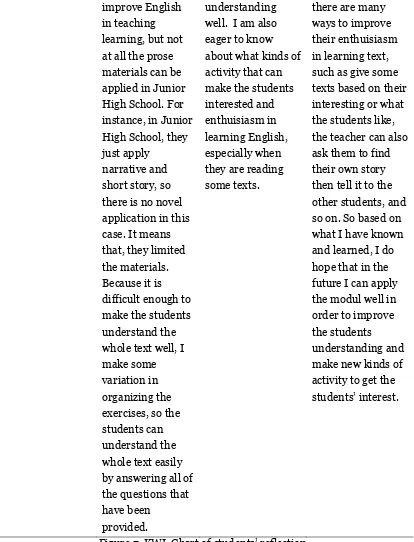PROCEEDINGS OF THE INTERNATIONAL CONFERENCE ON UNIVERSITY-COMMUNITY ENGAGEMENT
SURABAYA –INDONESIA,2-5AUGUST 2016 263
Empowering English Language Teaching
Materials Selection through the Implementation
of Service Learning
R
IZKAS
AFRIYANIUIN Sunan Ampel Surabaya, Indonesia [email protected]
Abstract: A teacher is a course designer and materials provider. The selected materials should be useful, meaningful and interesting for students. Some teachers do not care a lot about materials selection and they may select any material or even use the same ones every time. In fact, this may demotivate their students. This is why, teachers’ candidate should be able to do a good material selection. This paper will describe how service learning is used to empower English Language Teaching (ELT) Materials Selection done in the final project of the Prose Class and the students reflection about the service learning. Private and Public Schools around Surabaya, Gresik, and Sidoarjo are chosen by the students to be the community partner in empowering students ELT Materials Selection. The result shows that service learning is helpful to empower students ability in selecting ELT Materials. Both students and the community partner get the mutual benefit based on their need. Students reflections shows positive response to the service learning process.
Keywords: service learning, empower, material selection
Introduction
A key component in a most language program is teaching material. There are many kinds of teaching materials such as textbook, institutionally
264 PROCEEDINGS OF THE INTERNATIONAL CONFERENCE ON UNIVERSITY-COMMUNITY ENGAGEMENT
SURABAYA –INDONESIA,2-5AUGUST 2016
as (a) printed materials such as books, workbooks, worksheets, or readers, (b) non-print materials such as cassette or audio materials, videos, or computer-based materials, (c) materials that comprise both print and non-print sources such as self-access materials and materials on the internet1.
Additionally, there are some materials which are not designed for instructional use such as magazines, newspapers, and TV materials may also play a role in the curriculum.
Some teachers use instructional materials as their primary teaching resource. The materials provide the basis for the content of the lesson, the balance of skills taught, and the kinds of language practice students take part
in. In other circumstances, materials assist primarily to addition the teacher’s
instruction. For learners, materials may provide the main source of contact they have with the language separately from the teacher. Later the role and uses of material in a language program are a significant aspect of language curriculum and development. Instructional materials selection should be selected wisely because instructional materials are a primary resources for English Language Teaching process. Careful selection of english teaching materials are important to determine the planning of the teaching process. Materials selection should be composed based on the aims and the objectives of the teaching program and the learning or teaching situation in which the material will be used. Therefore, selecting course book involves matching the material against the context in which it is going to be used. No course book designed for a general market will be absolutely ideal for particular group of learners, but the aim is to find the best possible fit, together with potential for adapting or supplementing parts of the material where it is inadequate or unsuitable.
University Community Engagement is believable as the way to strengthen the relation between university and their community partner. In relation with the context of ELT materials selection, students should engage with the teacher who know more about the aims and the objectives of the teaching program and the learning or teaching situation in which the material will be used. Theoretically, students know how to select the teaching materials but without the actual context of teaching process, students work may not fit the the needs. According to the preliminary research, some Indonesian teachers say that they are busy with their tight schedule and have
PROCEEDINGS OF THE INTERNATIONAL CONFERENCE ON UNIVERSITY-COMMUNITY ENGAGEMENT
SURABAYA –INDONESIA,2-5AUGUST 2016 265 no time to create their own material regularly. They tend to use the text book provided by the school to teach. Some teachers even do not know their teaching objective, they just teach the book to the students and use the same book every year2. Based on this result of the interview, service learning is believable as one of the alternate way to give the solution for the teachers’
problem in selecting English teaching materials. Moreover, it gives benefit to the students to study how to create english material selection which fit the actual context. With this framework, service learning is expected to empower the quality of the english material selections composed by the students. However the study about service learning in English material selection in Indonesia is quite limited. Therefore, this study aims to describe how service learning is used to empower English Language Teaching (ELT) Materials Selection done in the final project of the Prose Class and the students reflection about the service learning. The following research questions are developed to inform the study:
“To what extent service learning is used to empower English Language Teaching (ELT) Materials Selection done in the final project of the Prose Class?”
Literature Review
Instructional MaterialInstructional materials are the tools used in educational lessons, which includes active learning and assessment. It is known that any resource a teacher uses to help the teaching process is also considered as an instructional material. Instructional materials are also defined as a variety of materials in any format which influence the student's learning and the instructor's teaching. There are some common types of Instructional materials such as Traditional resources, Graphic organizers and teacher made resources. They include, but are not limited to, textbooks, library books, periodicals, pamphiets, art prints, study prints, pictures, films, filmstrips, slides, videocassettes, videodiscs, audio cassettes, sound recordings, compact discs, computer software, CD-ROMS, and electronic resources.
Traditional resources include any textbooks and workbooks used in the classroom. For example, language arts classrooms almost always have literature textbooks, writing textbooks, and even vocabulary and spelling
266 PROCEEDINGS OF THE INTERNATIONAL CONFERENCE ON UNIVERSITY-COMMUNITY ENGAGEMENT
SURABAYA –INDONESIA,2-5AUGUST 2016
workbooks. In addition to these, traditional resources also include any supplemental reading material, like novels or poems outside of the textbook. Most textbooks and workbooks have already been designed to align with certain educational standards and are therefore very reliable in regards to addressing classroom goals. Still, it is important to be sure to choose material within the textbooks that matches teachers’ specific learning objective.
Graphic organizer is any type of visual representation of information. Diagrams, charts, tables, flow charts, and graphs are all examples of graphic organizers. In language teaching, Venn diagrams and plot diagrams are clear instructional tools to use when comparing or analyzing events in a piece of literature. All these graphic organizers allow students to physically see relationships between ideas. This is imperative for learning, especially for students who are more visually oriented. Seeing a clear relationship is always easier than an abstract idea in the students’ mind.
Teacher made resources is anything teacher creates like handouts, worksheets, tests, quizzes, and project. Teacher made resources are frequently used as an assessment in the classroom. The effectiveness of instructional materials depends on the manner and the degree to which they meet the needs of teachers and students. Therefore, teacher should analyze
the students ‘need in selecting English Teaching Materials for the teaching process. In selecting instructional materials, teacher will consider the following important points:
1. Illustrations. Illustrations are important because many people,
especially children with developing reading skills, form impressions based on the visual presentation of ideas. It is important that illustrations avoid portraying characters as stereotypes or caricatures. Thought should be given as to whether members of cultural groups, including female characters or persons with disabilities, are depicted in passive or inconspicuous ways. An assessment should also be made to determine if the illustrations are being used to accurately portray a certain culture or as a stereotypic representation.
2. Fiction and poetry. Novels and poems display a wide use of literary
PROCEEDINGS OF THE INTERNATIONAL CONFERENCE ON UNIVERSITY-COMMUNITY ENGAGEMENT
SURABAYA –INDONESIA,2-5AUGUST 2016 267 These factors should also be explained carefully when such materials are presented to students.
3. Life Style. Presentations of lifestyles should be examined for accuracy.
They should also seek to avoid oversimplification or the implication that racial groups are limited to any one lifestyle or socioeconomic condition. There should also be an awareness of how the family structures and relationships of various groups are portrayed in materials.
4. Language. Words are powerful tools and convey meaning through
inference and overtone. Evaluators need to be sensitive to language which is subtly sexist or racist. They need to be aware of the ways in which words and phrases reflect biased perspectives.
5. Heroes. Those involved in building collections of materials should
analyze characters portrayed as heroic to determine if there is a representation from all diversity groups. The characters should reflect those qualities deemed heroic by the cultural group they represent.
6. Effect on Student's Image of Self and Others. All students seek to
find images and words that accurately reflect their own experiences, heritage, and culture. Of course, students want to, and should, see themselves, their ancestors, and other members of their diverse group in a positive light. Materials should also present accurate portrayals of history, including inequities experienced by various groups.
7. Author's/Illustrator's Background and Perspective. Authors and
artists have their own cultural heritage and context. Evaluators should be aware of the background and experiences of the creators of instructional resources and of the qualifications and authority they bring to their work.
8. Copyright Date. A recent copyright date is no guarantee of sensitivity to
education that is multicultural, but it may provide more sophisticated and relevant treatment than is generally found in older resources.
This study focuses on the use of fiction as the major important point to be created as the instructional materials in English Language Teaching because fiction is a part of prose and it is taught in the junior high school level and the senior high school level as well. Students will work together with the teacher to consult the suitable context of the materials.
Service Learning
268 PROCEEDINGS OF THE INTERNATIONAL CONFERENCE ON UNIVERSITY-COMMUNITY ENGAGEMENT
SURABAYA –INDONESIA,2-5AUGUST 2016
projects that serve the community while building social, civic, and academic skills.3 learning is a pedagogical strategy, not an outcome.
Service-learning is an opportunity for students to develop Common Core skills and 21st century skills (Collaboration, Communication, Creativity, and Critical Thinking/Problem Solving) through project preparation and development, execution, and reflection. A service-learning project is a civic learning experience that allows students to connect what they are learning in class to contribute to the common good in their schools and communities. All service projects must include preparation, action and reflection. Service-learning projects should meet the following standards of excellent practice: student voice, meaningful service, curriculum integration, reflection, community partnerships, progress monitoring, diversity and duration and intensity. Here is comparative form, the typology is helpful not only in establishing criteria for distinguishing service-learning from other types of service programs but also in providing a basis for clarifying distinctions among different types of service-oriented experiential education programs (e.g., school volunteer, community service, field education, and internship programs)4
Figure 1. Sigmon in Furco : service and learning typology
From the figure above, it can be seen that there are 4 major different perspectives toward the service and the learning typology. The first typology put the learning as the primary goal as it is done the form of internship program. Internships programs engage students in service activities primarily for the purpose of providing students with hands-on experiences that enhance their learning or understanding of issues relevant to a particular area of study. In internship programs the students are the primary intended beneficiary and the focus of the service activity is on student learning.
3http://cps.edu/ServiceLearning/Pages/Guidelines.aspx retrieved on 26 May 2016
4 Andrew Furco in http://www.wou.edu/~girodm/670/service_learning.pdf retrieved on 26
PROCEEDINGS OF THE INTERNATIONAL CONFERENCE ON UNIVERSITY-COMMUNITY ENGAGEMENT
SURABAYA –INDONESIA,2-5AUGUST 2016 269 Students are placed in internships to acquire skills and knowledge that will enhance their academic learning and/or vocational development. For many students internships are performed in addition to regular course work often after a sequence of courses has been taken. Internships may be paid or unpaid and take place in either for profit or nonprofit organizations. Although the student is providing a service, the student engages in the internship primarily for his/her benefit and primarily for learning (rather than service) purposes. Along with internship, Field Education programs provide students with co-curricular service opportunities that are related, but not fully integrated, with their formal academic studies. Students perform the service as part of a program that is designed primarily to enhance students' understanding of a field of study, while also providing substantial emphasis on the service being provided.
The second typology put the service as the primary goal as it is done the form of volunteerism. Volunteerism is the engagement of students in activities where the primary emphasis is on the service being provided and the primary intended beneficiary is clearly the service recipient. James and Pamela Toole in Furco define the term volunteerism as people who perform some service or good work of their own free will and without pay. Although the student-volunteers may receive some benefits from the experience (e.g., feeling pleased with themselves) as well as learn something in the process, these outcomes are clearly serendipitous and unintentional. along with volunteerism, Community service is the engagement of students in activities that primarily focus on the service being provided as well as the benefits the service activities have on the recipients (e.g., providing food to the home- less during the holidays). The students receive some benefits by learning more about how their service makes a difference in the lives of the service recipients. community service programs involve more structure and student commitment than do volunteer programs. Community service programs involve more structure and student commitment than do volunteer programs.
270 PROCEEDINGS OF THE INTERNATIONAL CONFERENCE ON UNIVERSITY-COMMUNITY ENGAGEMENT
SURABAYA –INDONESIA,2-5AUGUST 2016
academic context and be designed in such a way that ensures that both the service enhances the learning and the learning enhances the service. Unlike a field education program in which the service is performed in addition to a student's courses, a service-learning program integrates service into the course(s).
The description about different service program above can be summarized below:
Figure 2. Different service programs in Education
From the figure above, each service program has different focus and service learning introduce the balance requirement of the learning and the service. In order to qualify as a service-learning project5, a service experience
must include the following components:
Preparation - Students prepare for their service by learning about the issue, building their skills and knowledge, and developing an action plan for service.
Action - Students engage in meaningful service by working on a project that will make a difference in their community and is tied to their classroom curriculum.
Reflection - Teachers enable students to analyze and make sense of their experience through discussion, journaling, and presentation opportunities.
PROCEEDINGS OF THE INTERNATIONAL CONFERENCE ON UNIVERSITY-COMMUNITY ENGAGEMENT
SURABAYA –INDONESIA,2-5AUGUST 2016 271 In this study, the three components are designed in the curriculum of the courses. Service learning is integrated within the lesson plan and the reflection stage is considered as the final examination of the courses.
Methodology
This study is a qualitative research which describes the phenomenon about the implementation of service learning in empowering English Materials Selection created by English Teacher Education Department students in Prose Class. Some quantitative data are used to support the description. Three classes of third semester students were chosen as the subject of the study. Fifty eight unit of Materials selection were analyzed and twenty eights schools were involved. In doing the service learning, students work in group in creating English Material Selection but they still have to work individually in writing personal reflection. In doing their service learning, students chose their own community partner which has a partnership with the university. Document study, observation and interview are used to gather the data. Scoring Sheet of English Material Selection were created together with the literature lecturer team. In analyzing the data, coding were given to the data which belong to different school / community partner and then the data were presented descriptively.
Findings
Empowering English Language Teaching Material Selection Through The Implementation of Service Learning
In designing course based service learning, lesson plan should be designed carefully. With a big number of students, grouping method was done randomly to avoid subjectivity. Twenty nine groups were formed and students created an ELT Material Selection. There were three major component of the activity in the implementation of the service learning which is described below:
1. Preparation
Preparation stage was done on the 10th meeting of the courses. On this
272 PROCEEDINGS OF THE INTERNATIONAL CONFERENCE ON UNIVERSITY-COMMUNITY ENGAGEMENT
SURABAYA –INDONESIA,2-5AUGUST 2016
the service learning, while they’re creating ELT Material selection6.
According to the result of the interview with English Mentor Teacher, they needed to have a supplementary English Material Selection as an alternate teaching material since they had no time to make it. The ELT material selection were given to the English Mentor Teacher as the product of the students services. Another services offered to the community partner were some services that the students might do, for example creating digital teaching media such as presentation slide, blog, and etc. Moreover, students also wanted to teach English conversation program at the community partner to give their services because some schools have English conversation program.
2. Action
Action stage was done for four weeks. On this stage, students started to select English Material for junior high school/senior high school level based on the result of the grouping. Students worked individually to select Prose English Materials from any sources and compiled it into two units of English Language Teaching Material Selection. Next, students should consult their draft of their work to the mentor teacher with the following instrument:
Figure 3. Scoring Sheet of English Material Selection Draft
PROCEEDINGS OF THE INTERNATIONAL CONFERENCE ON UNIVERSITY-COMMUNITY ENGAGEMENT
SURABAYA –INDONESIA,2-5AUGUST 2016 273 Theoretically, students know how to select English Material Selection effectively and create a good unit of material selection. There were 10 aspects of the materials selection that they should consider, among them; content validity, grammar, type of prose, quality of the activities, difficulty level of the activities, difficulty level of the reading text, clarity of the instruction, creativity, readibility of the text, and proper time allocation. Students started to select material based on the curriculum. They would choose the competence taken from the national curriculum7. Next, the students
prepared a reading text for each chapter and created some teaching activities to teach English in the classroom. The type of communicative activities created by the students are majorly presented within the unit that they have created. Each unit was created for one meeting for teaching English. For junior high school, students created a unit of instructional material selection for 80 minutes and for senior high school, students created a unit of instructional material selection for 90 minutes. Students should consider the proper material and proper time to finish the communicative activities created by the students in their English Material Selections.
Figure 5. English National Curriculum for Junior High School
In this context, students chose competence no. 3.6 because prose is related to narrative text in the form prose. Students might choose a fable, a
274 PROCEEDINGS OF THE INTERNATIONAL CONFERENCE ON UNIVERSITY-COMMUNITY ENGAGEMENT
SURABAYA –INDONESIA,2-5AUGUST 2016
legend, a folktale or another simple narrative text as the readings. Next, students would determine the difficulty level and the type of the communicative activities created.
In this stage, students could work in team to determine the readibility level, and the difficulty level of the reading and the activities but they have no experience in teaching students. Therefore, the involvement of community partner would help students to get the context and proper analysis among 10
requirements. The teacher’s engagement in giving feedback on their scoring Sheet of English Material Selection draft obviously help students to improve the quality of ther material selection unit. Consulting their draft, students would get responses, suggestions and recommendation for each unit that they had written. The example of the teachers responses can be seen in the following table:
Figure 4. Scoring Sheet of English Material Selection Draft
PROCEEDINGS OF THE INTERNATIONAL CONFERENCE ON UNIVERSITY-COMMUNITY ENGAGEMENT
SURABAYA –INDONESIA,2-5AUGUST 2016 275 some observation to the teachers’ class so that they could know the students level / competence and revised the work. The revised work would be given to the teacher and then evaluated by the teacher. The example of final score of English Material Selection from the teachers perspective can be seen below:
Figure 5. Scoring Sheet of English Material Selection Final Product
From figure 5, we could see how teacher could empower the process of English Material Selection created module. This product is considered as teacher made resources instructional material because it is created for the teaching purpose. It involves teachers and university students’ perspective about all of the aspect in creating English Language teaching Materials Selection. If students from university didnt work with the teacher, the could not get a qualified English Language teaching Materials Selection which suite the need of students at school. Students work would possibly useless for teacher because their English Language teaching Materials Selection is probably too easy or too difficult for junior high school / senior high school students.
276 PROCEEDINGS OF THE INTERNATIONAL CONFERENCE ON UNIVERSITY-COMMUNITY ENGAGEMENT
Figure 6. Score of ELT Material Selection from 58 students work
From figure 6, the general score are taken from the average score of all units created by the students. There are 10 aspects that should be scored good or fair and the average score show that 90% of the students get good score for the final product and only 30% of the students get fair score on their final product. Some students who get fair score, mainly created some errors on the grammar aspect. Because the service learning process are done for the benefit of the teacher and the students, most teacher gave a lot of suggestions to the students to revise the English Material Selection. Their products are given to the teacher so that it can be used in the teaching process.
Reflection
PROCEEDINGS OF THE INTERNATIONAL CONFERENCE ON UNIVERSITY-COMMUNITY ENGAGEMENT
Figure 7. KWL Chart of students’ reflection
278 PROCEEDINGS OF THE INTERNATIONAL CONFERENCE ON UNIVERSITY-COMMUNITY ENGAGEMENT
SURABAYA –INDONESIA,2-5AUGUST 2016
wanted to know commonly answered after the process. Just like student A, she wanted to know about activity that can make the students interested and enthuisiasm in learning English, and after the process of service learning she learned that she could give some texts based on their interest or what the students like, the teacher could also ask them to find their own story then tell it to the other students. The KWL chart facilitates students to make personal reflection organized, and simple to be understood.
Generally, from all of the students’ reflections and the interview result, we could find out that students generally enjoy the service learning process.
Students’ know how to work collaboratively with teachers. They’re happy
because most teacher gave a positive response and helpful to improve their English Language Teaching Material Selections. At first, they were afraid to meet the teachers, but after regular meeting with the teacher, they could enjoy the process. They’re happy because they could listen to the teachers experience and got the experience to observe their classroom on the early semester.8 They also feel happy because their material selection would be
used by the teacher in the teaching process. Therefore they do the best for the project.
In its broadest sense, empowerment is the expansion of freedom of
choice and action. It means increasing one’s authority and control over the resources and decisions that affect one’s life.9 As people exercise real choice,
they gain increased control over their lives. In education context, it's something collective such as the diverse imaginations, observations, opinions, hopes and dreams of students. By empowering students, teacher can engage them further in learning, provide a more democratic learning experience. In this study, there are three ways to empower students though the use of service learning; First teacher gives students a voice to choose their own idea and share their opinion and hopes. Students have a forum to provide constructive and timely feedback when it also helps students, emphasizing that learning is about partnership and working together. Second, teacher gives students decision making in the area of curriculum so that students have the power to choose creates a sense of ownership over the learning. The last way is involving students in the real issues. They're learning to help others. They study what is applicable to the real world and
PROCEEDINGS OF THE INTERNATIONAL CONFERENCE ON UNIVERSITY-COMMUNITY ENGAGEMENT
SURABAYA –INDONESIA,2-5AUGUST 2016 279 they'll be more motivated to learn further because they're seeing that it's having an impact.
This study has shown as a simple form of democratic learning experience which promotes students empowerment. It can be seen from the process of choosing materials selection, determining community partner and writing reflections. Students have a voice or freedom to express their opinion and they could get feedback from others. They did also learn to help others since they work in group and give services to the community partner. They work with the recent issues at school and believe that their product is applicable in the classroom because they have worked together with the teacher who knows more about the classroom context.
Conclusion
Service learning is helpful to empower students’ ability in selecting ELT Materials. The purpose of empowerment is to free someone from control by instructions and orders and give them freedom to take responsibility for their own ideas and actions, to release hidden resources which would otherwise remain inaccessible. A key element to empowerment being facilitated effectively on the ground is participation. Both students and teacher participate actively in the service learning process so that the empowerment can be reached out. Both students and the community partner get the mutual benefit from the process and students feel positively motivated through the process.[]
References
Jack. C. Richards. 2001. Curriculum Development in Language Teaching. United States of America: Cambridge University Press
Tomlinson, B. 2011. Materials Development in Language Teaching. (2nd ed) Cambridge: Cambridge University Press
Cunningsworth A .1995. Choosing Your Coursebook. Oxford:Heinemann Publishers Ltd.
Andrew Furco. Civic Engagement & Service Learning in
http://www.-wou.edu/~girodm/670/service_learning.pdf retrieved on 19 May 2016
Civic engagement and Service Learning in
280 PROCEEDINGS OF THE INTERNATIONAL CONFERENCE ON UNIVERSITY-COMMUNITY ENGAGEMENT
SURABAYA –INDONESIA,2-5AUGUST 2016
Litz DRA .2005. Textbook Evaluation And ELT Management:A South Korean Case Study, Thesis. Retrieved on March, 10, 2009 from http://www.asian-efl-journal.com/Litz_thesis.pdf
Perkins, D. & Zimmerman, M. 1995. Empowerment theory, research, and
application. American Journal of Community Psychology 23, 569-580
